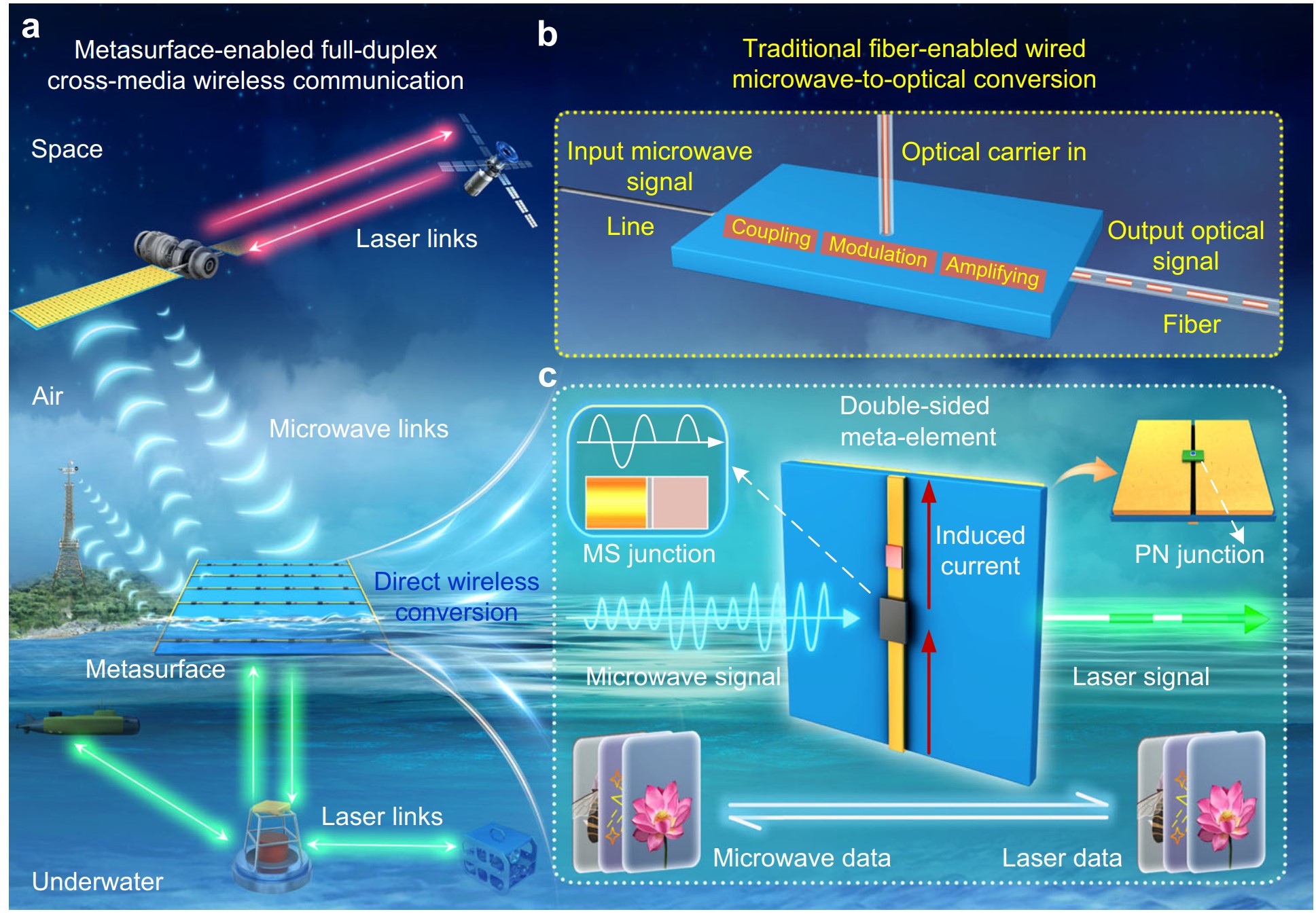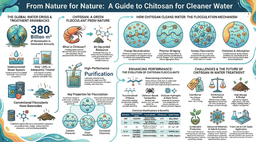Wireless microwave-to-optical conversion via programmable metasurface without DC supply
Published in Materials
Seamless conversion between microwave and optical domains is essential for next-generation communication and sensing systems. However, state-of-the-art microwave-to-optical converters are realized by fiber and circuit approaches with multiple processing steps, and external powers are necessary, which limits their applicability in wireless and free-space scenarios. Motivated by this gap, we sought to develop a programmable metasurface capable of direct and efficient microwave-to-optical conversion without requiring a DC power supply, paving the way for innovative applications in cross-media communication (Fig.1).

Fig. 1 | Existing wired scheme versus our metasurface-empowered wireless approach for microwave-optical conversion. a Schematic of the metasurface converter and its attractive application in full-duplex air-water cross-media wireless communications for establishing a seamless satellite-air-ground-ocean network. b Traditional microwave-to-optical conversion based on microwave photonics techniques, where the microwave signal and optical carrier need to be input simultaneously, and then the microwave data are mapped onto the output optical signal using electro-optic modulation. c Direct free-space microwave-to-optical conversion using metasurface, which is realized by integrating MS junction and photoelectric PN junction components into meta-elements with double-sided microwave resonant structures. With this hybrid design, the input microwave signal can be converted directly into laser signal, without additional optical carrier feeding, wired power suppliers, and separation processes. Moreover, the reverse conversion from laser to microwave can be also realized on one platform, achieving bidirectional operation.
To realize the free-space microwave-optical conversion, early on, we identified a promising solution in the form of a metasurface that integrates subwavelength microwave resonant structures and sensitive components. Translating this concept into a practical functional device, however, presented significant technical challenges. The metasurface converter either failed to generate laser emissions or exhibited a slow response speed during bidirectional operations. In addition, one of the most frustrating phases was testing the device for free-space communication. The signal conversion process appeared flawless in isolated setups, however, when integrated into a system, the outcomes were inconsistent. Such a kind of difficulty prompted us to rethink our technical approach, emphasizing the interplay of physics, materials, and system architecture.
Through elaborate design and iterative optimizations, we identified key adjustments to the geometry, material properties and integrated components of the programmable metasurface, enabling it to achieve reliable microwave-to-laser conversion. Moreover, the reverse conversion from laser to microwave was also realized on one platform, achieving bidirectional operation. The moment when the device first demonstrated successful operation was a significant step, confirming the feasibility of our approach. To validate the practical utility of metasurface, we developed a full-duplex air-water cross-media wireless communication system, a challenging scenario due to the inherent noise and signal distortion at the air-water interface. Early trials revealed degradation in data transmission quality, necessitating further refinements to the metasurface and system configuration. Through careful tuning and systematic experimentation, we achieved real-time, bidirectional data transmission across the air-water boundary (Fig.1c). This demonstration underscored the versatility and robustness of the metasurface, proving its effectiveness in complex and cross-media environments. Witnessing the system successfully achieve cross-media communication marked a defining moment for the team, representing the culmination of months of dedicated effort and perseverance while highlighting the transformative potential of this interesting technology.
This research underscored the importance of interdisciplinary collaboration, integrating principles from microwave and optical physics with advanced metasurface engineering. The process revealed critical insights into the interplay between device design, materials, and system-level implementation. By addressing these challenges, we have laid the groundwork for direct and free-space microwave-optical conversion technologies. Looking ahead, we aim to enhance the efficiency and scalability of metasurface for broader applications, including integrated sensing and communication. We are also exploring ways to extend the technology to other cross-media interfaces, paving the way for innovative applications in extreme environments such as underwater and space exploration.
Lastly, we express our heartfelt thanks to the editor and reviewers for their invaluable and insightful comments, which have been most constructive. For example, they recommended that we pay attention to the impact of underwater turbulence on the transmission performance of metasurface, the potential of the metasurface-enabled air-water cross-media wireless links for satellite-ground-ocean integrated network, and comprehensive explanations of device and system operations. We believe that these suggestions further demonstrated our team’s competencies, and played a pivotal role in enhancing the quality of the manuscript.
This research received funding from the National Natural Science Foundation of China, the Natural Science Foundation of Jiangsu Province, the China National Postdoctoral Program for Innovative Talents, the China Postdoctoral Science Foundation, the Postgraduate Research & Practice Innovation Program of Jiangsu Province, the Fundamental Research Funds for the Central Universities, and the 111 Project.
See the article:
Xin Ge Zhang, Ya Lun Sun, Bingcheng Zhu, Han Wei Tian, Bo Yuan Wang, Zaichen Zhang, Cheng-Wei Qiu, Tie Jun Cui and Wei Xiang Jiang. Wireless microwave-to-optical conversion via programmable metasurface without DC supply. Nature Communications, 2025, 16(1): 528.
Follow the Topic
-
Nature Communications

An open access, multidisciplinary journal dedicated to publishing high-quality research in all areas of the biological, health, physical, chemical and Earth sciences.
Related Collections
With Collections, you can get published faster and increase your visibility.
Women's Health
Publishing Model: Hybrid
Deadline: Ongoing
Advances in neurodegenerative diseases
Publishing Model: Hybrid
Deadline: Dec 24, 2025




Please sign in or register for FREE
If you are a registered user on Research Communities by Springer Nature, please sign in